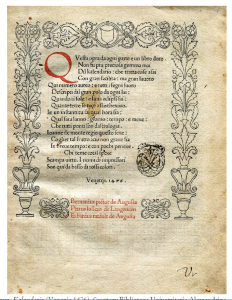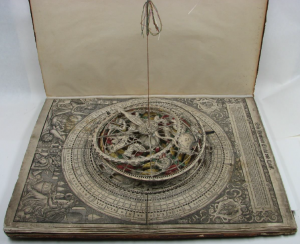It struck me increasingly hard as I reached the end of my last post that I didn’t really know the history of astronomical volvelles in manuscripts. That is, pretty much all the astronomical volvelles I’d actually seen images of were either in incunabula or were from the 16th century (printed books or otherwise). For example, while revisiting Regiomontanus recently, I noted that his 1476 printed Kalendario contained volvelles. But what about volvelles in 14th and 15th century manuscripts?
Looking for useful sources, I found Jessica Helfand’s (2006) “Reinventing the Wheel“: though probably unlikely to be of precise relevance to what I’m looking for, it does look like a fun read. But then I found Gianfranco Crupi…
Gianfranco Crupi
My search for the history of manuscript astronomical volvelles only began properly when I stumbled upon Gianfranco Crupi’s (2019) “Volvelles of knowledge. Origin and development of an instrument of scientific imagination (13th-17th centuries)” in the Italian Journal of Library, Archives, and Information Science (JLIS.it). I’d describe this as a well-illustrated whistlestop tour through the history of volvelles. (And would recommend it as a nice accessible read too. 🙂 )
Crupi cracks crisply onwards from Lull to Matthew Paris’ Chronica Majora to Wheels of Fortune to Alberti’s cipherdisk to Fontana to Trithemius to Della Porta; and then from Regiomontanus’ Kalendario with its remarkably beautiful front page…
…to Petrus Apianus and to the extraordinary Dess Menschen Circkel…
…and to Ottavio Pisani’s volvelles. As I mentioned, this is a nice little read. 🙂
As far as astronomical volvelles in manuscripts go, Crupi lists three articles:
- Bennett, Jim. 2011. “Early Modern Mathematical Instruments” Isis 102, 4:697−705.
- Gingerich, Owen. 1993. “Astronomical paper instruments with moving parts.” In Making instruments count: Essays on historical scientific instruments presented to Gerard L’Estrange Turner, edited by R. Anderson, J. Bennett, W. Ryan, 63−74. Aldershot: Variorum. (Abstract: “Discusses the development and decline of early printed books with moving parts, as teaching demonstrations or for actual calculations, chiefly of the 16th c.“)
- Kremer, Richard L. 2011. “Experimenting with paper instruments in fifteenth- and sixteenth-century astronomy: computing syzygies with isotemporal lines and salt dishes.” Journal for the History of Astronomy 42, 147:223−258.
Even though Bennett’s article is available online, it only discusses volvelles briefly, and not really in manuscripts at all. And much as I love everything by Owen Gingerich (am I the only person who read his “The Book Nobody Read”?), his 1993 article’s abstract indicates that the primary focus there was on volvelles in printed books, so it is probably not relevant here.
However, because Kremer’s footnotes are online, I was extremely excited to find out from them that he talks extensively about Gotha Chart. A 472 (yes, the same manuscript I mentioned a few days ago). And so it should be no surprise that article is definitely what I want to read next.
Can I therefore ask if any of my lovely Cipher Mysteries readers with institutional access would please be so kind as to send me a copy of Kremer’s JHA article (Sage Journals, accessible via Shibboleth or Open Athens) so that I can continue following this volvelle research strand onwards? Thanks! 🙂


In the usual way, I could request a copy be made and emailed or posted to you by my university library, but having enquired, it seems the shut-down there is complete for the time being. Sorry.
Also just fyi, most articles from the JHA (but not this one) can be found at Researchgate and other sites such as NASA. Haven’t checked the latter, but it’s not at the former.
I trust that another of your readers will have better luck.
Sorry, my university library is listed, but it has no access to this content.
“It struck me really hard….that I didn’t really know the history of….”
Aw, don’t feel bad. When I started looking into the native Aztec Meso-Americans hypothesis, I thought Nahuatl was the only language and that there was only one basic dominant tribe.
Regarding Mayans, recent Lidar scans show cities and civilization far more extended than we knew. We are where Egyptologists were in 1850 in this line of research.
I suspect the same with regard to document availability and European related manuscript research. Give it another 20-30 years at least and you won’t have to request someone email you anything, it will all be out there.
In time there will be not only the ability for textual comparisons, but probably even AI’s that can make probabilistic guesses about handwriting similarities and authorship.
Interesting diagrams, by the way.
bi3mw: no problem, I’ve just (very kindly) had a copy sent through to me by JT, so I’m now back in business. 🙂
I ran your latest posts by our historian and head of collections, Pedro Raposo, here at the Adler Planetarium. He suggested reaching out to Richard Kremer at Dartmouth. I can send his contact info to you if you’d like.
Ken: thanks very much indeed for the offer, but in all fairness it’s a little early just yet – I’ve still got a lot of literature to read and digest (which I’ll be blogging about here as I find it) before I’m even on the same book as Richard Kremer, let alone the same page. 😉
From what I already know, there seems to be a lot of reasons to be optimistic that the Voynich Manuscript’s Q9 and Q10 will turn out to be – in some hard-to-pin-down way – connected to exactly the kind of early-to-mid-fifteenth century German astronomical paper instrument innovation Richard Kremer has written about. In fact, I believe I wrote to Pedro Raposo at the Adler a few years back when I was wondering whether f57v might actually be a nocturlabe, which similarly seems to have popped up in Germany during the mid-fifteenth century. So I have form. 😉
Hopefully in a couple of weeks’ time this will all have started to take proper shape, to the point where I even know what the right questions to be asking are. 🙂